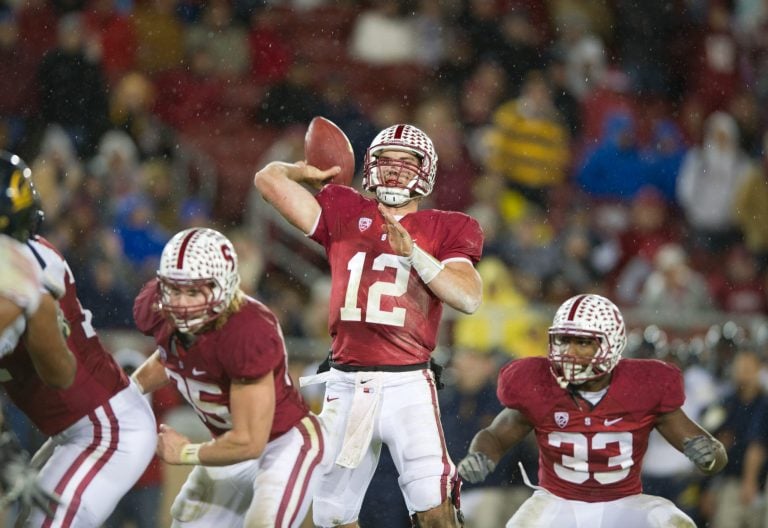It is the most important week in Bay Area collegiate sports — Big Game Week. Fans have witnessed many impressive performances from Stanford and Berkeley players alike in college and in the NFL. So, in anticipation of the Cardinal facing the Golden Bears, I thought to myself: “Who were some of the best players to ever play in Big Game, and how would they fare against each other?”
To answer that question, I used WhatIfSports — an online sports-simulation website — to simulate an all-time Big Game between the best of the best of both schools.
One key thing to note about WhatIfSports is that they cannot do all-time rosters, as the players and statistics they provide only go back to 1997. As such, all-time greats like Stanford quarterback John Elway ‘83 will not be included in my simulation. In addition, there is no way to make all-time defenses for either team, so defenses will be from a specific year’s starting line-up, not made up of all-time players.
I chose the players for each team based on single-year performance statistics at their respective schools. When looking for quarterbacks, I evaluated their passing yards, touchdowns, yards per game and overall efficiency at game management. For running backs and receivers I focused on total yards gained and number of touches. For defenses, I looked at overall defensive efficiency and how they ranked when defending the run and pass in comparison to other teams from their respective university. For special teams, kickers and punters, I mainly focused on efficiency, distance (for punters) and field goal percentage (for kickers).
Given this methodology, who are the players on each team? Well, let me start off by introducing the Berkeley starters:
Players to note:
The dynamic offense centering around quarterback Aaron Rodgers, running back Marshawn Lynch and tight end Tony Gonzalez is lethal — all three should be in both the College Football and NFL’s Hall of Fame (if they are not already in it).
On defense, the 2004 Cal Golden Bears forced 11 turnovers and limited their opponents to just 320.9 yards total offense per game.
This is a tough team to beat, but if any team can, it is the all-time Cardinal team:
Players to Note:
The hardest thing with Stanford’s lineup is that when the Cardinal have a great player at a position, they also have two to three others who could easily be considered just as good. For example, choosing who should start at tight end between Zach Ertz ‘13, Colby Fleener ‘11 and Austin Hooper ‘16 was a toss up.
Besides that, Stanford’s lineup is loaded with talent all over the board. The offense has a star quarterback in Andrew Luck ‘12, along with running back Christian McCaffery ‘17 and Ertz, capable of making massive plays. In choosing the defense, the 2012 Cardinal allowed only 4.7 yards per play and forced 16 turnovers.
The teams are set, and the game is on!
The Game:
Stanford starts the game hot with consistent play from Luck. In the middle of the first quarter, Rodgers overthrows his receiver and is intercepted by Stanford, eventually setting up a touchdown by running back Toby Gerhart ‘09.
Cal comes back late in the quarter with a 62-yard run by running back Jahvid Best, but the Cardinal end the first quarter ahead 10-7.
After trading three-and-outs to start the second quarter, Luck passes the ball to WR Troy Walters ‘99 for a 14-yard touchdown. Later in the quarter, the Cardinal defense intercepts Rodgers at the Cal 20-yard line, which leads to an easy Fleener score. Stanford dominated the second quarter, going into the half up 24-7.
The Golden Bears start with the ball in the second half. However, after a three-and-out caused by a Stanford sack, the Cardinal get their offense back on the field and running back Bryce Love ‘18 rushes in for a touchdown. The Stanford defense stays stingy, putting the pressure on Rodgers and the Cal offense. When Stanford gets the ball back after a defensive stop, they drive down the field, ending on a McCaffrey seven-yard rushing touchdown. The quarter ends with Stanford up 38-7.
The Cal offense finally gets a break to start the fourth quarter with Gonzalez scoring a touchdown. And then, after forcing Stanford to turn the ball over on downs, Cal scores again with 3:23 left in the game after Rodgers passes to wide receiver Dameane Douglass for a seven-yard score. However, Cal misses their two-point-conversion attempt. After defensive stops by both teams, Stanford ultimately comes out victorious, 38-20.
The key theme of the game was Stanford’s dominant defense. The 2012 Cardinal squad intercepted two passes and sacked Rodgers seven times, causing Cal to lose 53 yards.
The player of the game was Luck, who completed 24-of-34 passes for 354 yards and two touchdown passes. Stanford dominated the game offensively and defensively.
While we will never know for sure who would win an all-time match-up in real life, this rivalry game is unlike any other in football or in all of college sports. While the Big Game lineups change each year, maybe a few currently on the field will soon join the all-time ranks.
